Background
"A Communication to my Friends" was written at a period which was turbulent even in the context of Wagner's very eventful life. Having been forced to flee Dresden, where he had been Kapellmeister at the Opera House, following his involvement with the May Uprising of 1849, he lived in exile, based in Zürich. He had no regular income and, although he had completed the score of his opera Lohengrin , he had at first little prospect of getting it performed, or of furthering his career as a composer. During the period 1849–51 he in fact wrote hardly any music, instead concentrating on writing a series of essays in which he expounded his ideas about music and the future of opera. These included "Art and Revolution" (written in Paris in 1849), "The Artwork of the Future" (1849), "Jewishness in Music" (1850) and the book-length "Opera and Drama" (1851).

Dresden is the capital city of the German state of Saxony, and with around 550,000 inhabitants, it is the state's second most populous city after Leipzig. It is the 12th most populous city of Germany, the fourth largest by area after Berlin, Hamburg and Cologne, as well as the third most populous city in the area of former East Germany, after (East) Berlin and Leipzig. Dresden is contiguous with Freital, Pirna, Radebeul, Meissen and Coswig, and its urban area has around 780,000 inhabitants, making it the largest in Saxony.
Kapellmeister is a German word designating a person in charge of music-making. The word is a compound, consisting of the roots Kapelle and Meister ("master"). The word was originally used to refer to somebody in charge of music in a chapel. However, the term has evolved considerably in its meaning in response to changes in the musical profession.

The May Uprising took place in Dresden, Kingdom of Saxony in 1849; it was one of the last of the series of events known as the Revolutions of 1848.
Franz Liszt however offered to premiere Lohengrin in Weimar, where he was Kapellmeister to the court, and the production took place there in 1850. In the wake of this it was proposed to publish the librettos of Wagner's three most recent operas, (all of which had been written, as was normal with Wagner, by the composer himself); Der fliegende Holländer , Tannhäuser , and Lohengrin.

Franz Liszt was a Hungarian composer, virtuoso pianist, conductor, music teacher, arranger, and organist of the Romantic era. He was also a writer, a philanthropist, a Hungarian nationalist and a Franciscan tertiary.

Weimar is a city in the federal state of Thuringia, Germany. It is located in Central Germany between Erfurt in the west and Jena in the east, approximately 80 kilometres southwest of Leipzig, 170 kilometres north of Nuremberg and 170 kilometres west of Dresden. Together with the neighbour-cities Erfurt and Jena it forms the central metropolitan area of Thuringia with approximately 500,000 inhabitants, whereas the city itself counts a population of 65,000. Weimar is well known because of its large cultural heritage and its importance in German history.
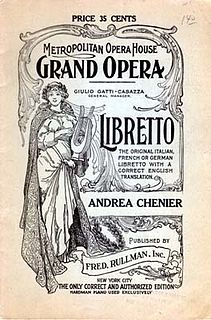
A libretto is the text used in, or intended for, an extended musical work such as an opera, operetta, masque, oratorio, cantata or musical. The term libretto is also sometimes used to refer to the text of major liturgical works, such as the Mass, requiem and sacred cantata, or the story line of a ballet.
However, Wagner was very conscious that his concept of opera had significantly moved on since writing these works, to the extent that they hardly met – and in some aspects fell a long way short of – the standards and principles he had set out in "Opera and Drama". This provoked comment amongst both Wagner's admirers and his critics. Conscious of this, he therefore wrote "A Communication to my Friends" intending it as a preface to the librettos, explaining the evolution of his ideas and the reason for these discrepancies. [1] 'I was burning to write Something that should take the message of my tortured brain, and speak it in a fashion to be understood by present life'. [2] Wagner wrote to his friend Theodor Uhlig of the essay 'This is a decisive work!' [3]

Theodor Uhlig was a German violin-player, composer and music critic.
Contents
Wagner's critique of the arts
The essay begins with an analysis of contemporary art-tastes, which Wagner castigates. Due to the materialism of the public 'only such artists can work in harmony with the present public taste as either imitate the monuments of the past, or stamp themselves as servants of the mode [fashion]; but both are, in very truth, no artists at all'. [4] Art is only to be drawn from 'life itself', and the only one of the arts which can meet his criteria for 'the warm-appealing Art-work' is drama. [5] Wagner proceeds to condemn the majority of modern artists, in painting and in music, as 'feminine [...] the world of art close fenced from Life, in which Art plays with herself.' Where however the impressions of Life produce an overwhelming 'poetic force', we find the 'masculine, the generative path of Art'. [6]

Drama is the specific mode of fiction represented in performance: a play, opera, mime, ballet, etc., performed in a theatre, or on radio or television. Considered as a genre of poetry in general, the dramatic mode has been contrasted with the epic and the lyrical modes ever since Aristotle's Poetics —the earliest work of dramatic theory.
Wagner's artistic development
The remainder of the essay traces the writer's artistic development hand-in-glove with his life story, confirming Wagner's identification of himself as one who wrings Art from Life, i.e. 'masculine', rather than a 'feminine' artistic freeloader. Admitting that with the early Rienzi 'I had it mind only to write an "opera" ', with Der fliegende Holländer 'I became, myself, the artistic modeller of a 'stuff' that lay before me only in the blunt and simple outlines of Folk-Saga' [7] Gradually, working to the forms of myth as he perceived them, in subsequent operas, Wagner begins to remodel the idea of opera.
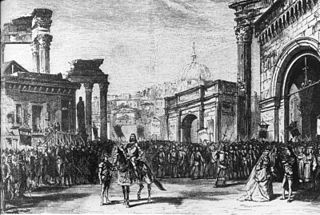
Rienzi, der letzte der Tribunen is an early opera by Richard Wagner in five acts, with the libretto written by the composer after Edward Bulwer-Lytton's novel of the same name (1835). The title is commonly shortened to Rienzi. Written between July 1838 and November 1840, it was first performed at the Königliches Hoftheater, Dresden, on 20 October 1842, and was the composer's first success.
'I by no means set out to destroy [..] the prevailing operatic forms of aria, duet, &c.; but the omission of these forms followed from the very nature of the Stuff, with whose intelligible presentment to the Feeling [...] I had alone to do.' [8]
Wagner unfortunately found that his audiences were not willing to follow where he led them:
The public, by their enthusiastic reception of Rienzi and their cooler welcome of the Flying Dutchman, had plainly shown me what I must set before them if I sought to please. I completely undeceived their expectations; they left the theatre, after the first performance of Tannhaüser, [1845] in a confused and discontented mood. - The feeling of utter loneliness in which I now found myself, quite unmanned me.[...] My Tannhaüser had appealed to a handful of intimate friends alone. [9]
Wagner's plans for the future
Wagner refers to some of his projects, including a drama Jesus of Nazareth (the draft for which was published after his death), [10] and his libretto Siegfried's Death [11] (which was eventually to evolve into the Ring cycle). He explains how he intends to apply his new techniques of opera to this libretto. [12] After relating his disastrous visit to Paris in 1849, [13] he gives credit to his 'wondrous friend', Franz Liszt, for standing by him and undertaking to stage Lohengrin. [14]
Finally Wagner announces:
I shall never write an Opera more. As I have no wish to invent an arbitrary title for my works, I will call them Dramas [...]
I propose to produce my myth in three complete dramas, preceded by a lengthy Prelude (Vorspiel). [...]
At a specially-appointed Festival, I propose, some future time, to produce those three Dramas with their Prelude, in the course of three days and a fore-evening. The object of this production I shall consider thoroughly attained, if I and my artistic comrades, the actual performers, shall within these four evenings succeed in artistically conveying my purpose to the true Emotional (not the Critical) Understanding of spectators who shall have gathered together expressly to learn it. [...] [15]
This is his first public announcement of the form of what would become the Ring cycle.
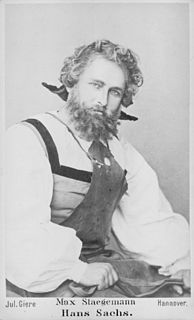
Die Meistersinger von Nürnberg, WWV 96, is a music drama in three acts, written and composed by Richard Wagner. It is among the longest operas commonly performed, usually taking around four and a half hours. It was first performed at the Königliches Hof- und National-Theater, today the home of the Bavarian State Opera, in Munich, on 21 June 1868. The conductor at the premiere was Hans von Bülow.
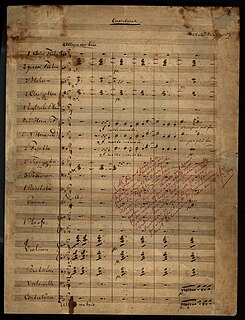
The Flying Dutchman, WWV 63, is a German-language opera, with libretto and music by Richard Wagner. The central theme is redemption through love. Wagner conducted the premiere at the Königliches Hoftheater in Dresden in 1843.

What's Opera, Doc? is a 1957 American animated cartoon comedy-drama musical short in the Merrie Melodies series, directed by Chuck Jones for Warner Bros. Cartoons. The Michael Maltese story features Elmer Fudd chasing Bugs Bunny through a parody of 19th-century classical composer Richard Wagner's operas, particularly Der Ring des Nibelungen, Der Fliegende Holländer, and Tannhäuser. It borrows heavily from the second opera in the "Ring Cycle" Die Walküre, woven around the typical Bugs-Elmer feud.
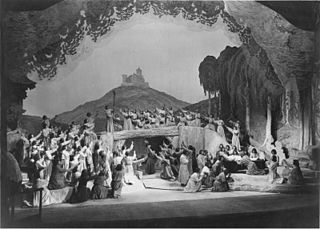
Tannhäuser is an 1845 opera in three acts, music and text by Richard Wagner, based on two German legends: Tannhäuser, the legendary medieval German Minnesänger and poet, and the tale of the Wartburg Song Contest. The story centers on the struggle between sacred and profane love, and redemption through love, a theme running through much of Wagner's mature work.

The evolution of Richard Wagner's operatic tetralogy Der Ring des Nibelungen was a long and tortuous process, and the precise sequence of events which led the composer to embark upon such a vast undertaking is still unclear. The composition of the text took place between 1848 and 1853, when all four libretti were privately printed; but the closing scene of the final opera, Götterdämmerung, was revised a number of times between 1856 and 1872. The names of the last two Ring operas, Siegfried and Götterdämmerung, were probably not definitively settled until 1856.
Dunja Vejzović is an acclaimed operatic soprano from Croatia.

The Bayreuth canon consists of those operas by the German composer Richard Wagner (1813–1883) that have been performed at the Bayreuth Festival. The festival, which is dedicated to the staging of these works, was founded by Wagner in 1876 in the Bavarian town of Bayreuth, and has continued under the directorship of his family since his death. Although it was not originally held annually, it has taken place in July and August every year since the 75th anniversary season in 1951. Its venue is the Bayreuth Festspielhaus, which was built for the first festival. Attendance at the festival is often thought of as a pilgrimage made by Wagner aficionados.
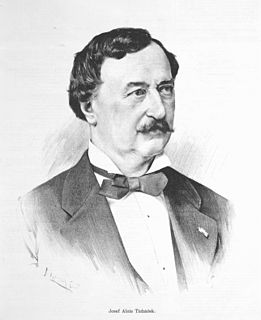
Josef AloysTichatschek, originally Ticháček, was a Bohemian opera singer highly regarded by Richard Wagner. He created the title roles in Wagner's operas Rienzi and Tannhäuser.
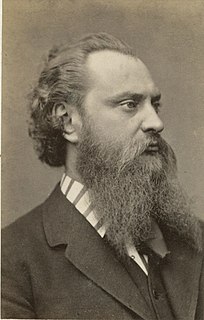
Albert Wilhelm Karl Niemann was a leading German tenor opera singer especially associated with the operas of Richard Wagner. He gave important premieres in France, Germany, England and the United States, and played Siegmund in the first complete production of Der Ring des Nibelungen.

Opera and Drama is a book-length essay written by Richard Wagner in 1851 setting out his ideas on the ideal characteristics of opera as an art form. It belongs with other essays of the period in which Wagner attempted to explain and reconcile his political and artistic ideas, at a time when he was working on the libretti, and later the music, of his Ring cycle.

"Art and Revolution" is a long essay by the composer Richard Wagner, originally published in 1849. It sets out some of his basic ideas about the role of art in society and the nature of opera.

"The Artwork of the Future" is a long essay written by Richard Wagner, first published in 1849 in Leipzig, in which he sets out some of his ideals on the topics of art in general and music drama in particular.
"Music of the Future" is the title of an essay by Richard Wagner, first published in French translation in 1860 as "La musique de l'avenir" and published in the original German in 1861. It was intended to introduce the librettos of Wagner's operas to a French audience at the time when he was hoping to launch in Paris a production of Tannhäuser, and sets out a number of his desiderata for true opera, including the need for 'endless melody'. Wagner deliberately put the title in inverted commas to distance himself from the term; Zukunftsmusik had already been adopted, both by Wagner's enemies, in the 1850s, often as a deliberate misunderstanding of the ideas set out in Wagner's 1849 essay, The Artwork of the Future, and by his supporters, notably Franz Liszt. Wagner's essay seeks to explain why the term is inadequate, or inappropriate, for his approach.
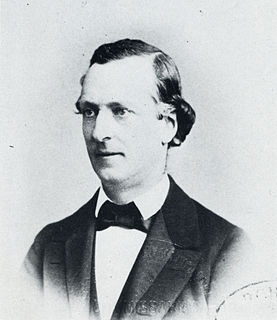
Charles-Louis-Étienne Nuitter was a French librettist, translator, writer and librarian born in Paris, France on 24 April 1828. He died there on 23 February 1899 after suffering a stroke a few days before.

Johann Michael Wächter was an Austrian bass-baritone most famous for appearing in the operas of Richard Wagner.
Gerd Brenneis was a German operatic tenor who had an active international career from the late 1950s through the 1990s. Known for his interpretations of the works of Richard Wagner, he worked as a principal artist at many of the world's great opera houses, including the Deutsche Oper Berlin, La Scala, the Metropolitan Opera, and the Vienna State Opera.























